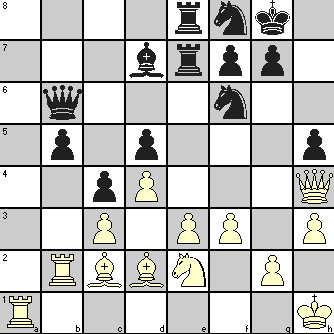You have seen how chess tactics was used for utilizing the power of a passed pawn to settle the outcome of a chess game. Let us now look at another game showing the greater might of united passed Pawns that Black obtained by sacrificing his pieces.
If you sit back and think, you will realize that such sacrificial moves, though looking so spectacular, are essentially not a sacrifice but only a long-term investment. Giving up one Rook for a Pawn and another Rook for a Bishop to get a passed Pawn that becomes a Queen is actually getting better of the bargain (Queen and bishop against two Rooks)! The brilliancy lies in identifying the possibility and deploying suitable chess tactics to make it a reality.
The position shown below was reached after 26 moves and Black initiated his combination with a stunning move that earned its place among the best moves in chess history.

As suggested before, see if you can find the move on your own after White played 27. Ng3, though this time it should not be difficult with the hint that you have got already. But finding the sequence of moves in the combination may prove to be more difficult.
Here is how the game went from the above position.
| 1. | Ng3 | Rxe3 | ||
| 2. | Bxe3 | Rxe3 | ||
| 3. | Nxh5 | Nxh5 | ||
| 4. | Qxh5 | Bc6 | ||
| 5. | Qg5 | Rxc3 | From a semi-passed QNP, Black has now got united QNP and QBP, albeit by giving up Rook against Bishop and Pawn and another such exchange to follow in next two moves | |
| 6. | Qd2 | Rxc2 | ||
| 7. | Rxc2 | Ne6 | Black threatened the last of White’s center pawns and White has to guard it | |
| 8. | Rd1 | b4 | The passed pawns have started exerting their power | |
| 9. | Rb2 | b3 | ||
| 10. | Qc3 | Nc7 | ||
| 11. | Re2 | Qa7 | ||
| 12. | Qb4 | Nb5 | ||
| 13. | Re7 | Qa3 | With those menacing passed pawns having the support of the Knight, Black could afford to exchange Queens, but not White | |
| 14. | Qe1 | c3 | But the Pawns go marching in! Black does not care if White wants to exchange his Rook for Black’s Bishop and Knight in the supreme confidence that two connected passed pawns on their 6th rank cannot be blocked by a Rook and Black Queen is there to take care of any interference by her counterpart! | |
| 15. | Re8+ | Bxe8 | ||
| 16. | Qxe8+ | Kh7 | ||
| 17. | Qxf7 | Qa8 | But White had a more sinister plan to salvage a draw and so went for Black’s KBP rather than his Knight! Black rose to the occasion to thwart White’s plan of salvaging a draw. For example: 17. … c2 18. Qh5+ Kg7 19. Qe8+ Kh7 20. Qh5+ Kg7 and draw by perpetual check. It shows that you can never be too careful even in a won position! | |
| 18. | Re1 | Nd6 | Threatens the Queen and guards the vulnerable e8 square | |
| 19. | Qc7 | c2 | With immediate threats taken care of, Black resumes the pawn march without bothering about the Knight | |
| 20. | Qxd6 | b2 | ||
| 21. | Qf4 | Qc6 | ||
| 22. | Resigns |


